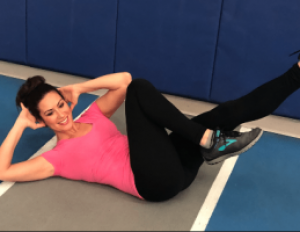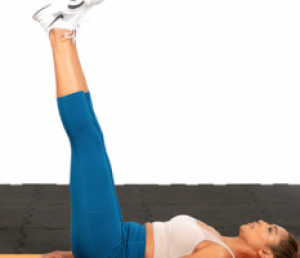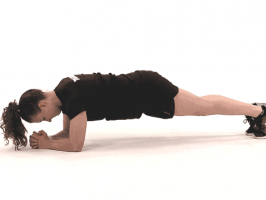Jim is an accomplished triathlete and endurance cyclist, and has raced in more than 35 USAT-certified races. He is also an avid trail runner and endurance gravel bike rider. Jim is a founder of Complete Tri and frequent writer on triathlon and cycling.
Cyclists assume that they need to have strong legs to improve their riding speed and distance. That’s true, but many overlook the core. A strong core is a key part of any cyclist’s conditioning.
A strong core is surprisingly critical to cycling.
Why Strengthen Your Core?
Improved Stability
Strong core muscles help to stabilize the body and increases balance. This is especially important for cyclists who may find themselves riding in difficult terrain or in bad weather. A strong core can help the cyclist maintain better control of their bike and remain upright, even in challenging conditions. Strong core muscles also make it much easier to get out of the saddle and stand-up while pedaling, something you should be doing when trying to muster more power or climb up that tough hill.
Enhanced Endurance
Core strength helps to improve your overall endurance on the bike. A strong core helps to support the body and can reduce fatigue, allowing the cyclist to go farther and faster. You will especially notice the benefits of a strong core in the final 25% of a long ride — you will have less overall fatigue and feel like your form is still good.
Reduced Risk of Injury
A strong core will keep you honest on your cycling form, meaning you will get fewer injuries. Misalignment is one of the main causes of cycling injuries, and if you are misaligned over a long ride, that could mean thousands of motions that actually hurt your body. Strong cores allow cyclists to ride in proper form, even when they start to get tired. When you combine good core work with other injury-prevention techniques like foam rolling or even ice baths, then you are starting to really focus on keeping yourself injury-free if at all possible.
More Aggressive Riding Positions
Anyone who has done a bike fitting will know that your core strength dictates how aggressive your bike can be setup. The stronger the core, the more aggressive you can be. Those with weaker cores often need their bike setup in a more relaxed position to compensate. You will also find that you can stay in your drop bars or your aerobars for longer periods of time, helping you on race day.
I have been working on my core for 15 years, and have seen the work translate to my cycling. I find that I am able to get out of the saddle and stand much more easily and with less weight on my wrists, that my form stays sound even into long rides, and that I can go into my drops or aerobars for much longer than before.
5 Great Core Exercises for Cyclists
Crunches
How to do them
Lie on your back with your knees bent and your feet flat on the ground. Place your hands behind your head, keeping your elbows out, or you can cross your arms across your chest. Engage your core and slowly raise your chest up towards your knees and then slowly lower back down. Repeat 10–15 times.
Why we love them
Crunches are the epitome of an ab working, and it is not hard to see how being good at them translates to holding yourself in a strong cycling position for hours at a time.
Plank
How to do them
Start in a pushup position, with your hands directly under your shoulders. Lower your forearms to the floor and hold yourself up in a straight line from your head to your heels. Hold for 30–60 seconds.
Why we love them
The ultimate exercise for building all of those stabilizer muscles around your core. By doing lots of plank you will be able to ride without having so much pressure on your arms and wrists.
Bicycle Crunches
How to do them
Lie on your back with your hands behind your head. Lift your legs off the ground and bring your right elbow to your left knee while straightening your right leg. Then switch sides and bring your left elbow to your right knee while straightening your left leg. Repeat 10–15 times.
Why we love them
As the name implies, this mimics the movement of cycling and is a more dynamic version of regular crunches.
Leg Raises
How to do them

Lie on your back and place your hands on the ground for support. Lift your legs off the ground and raise them until they are at a 90–degree angle from your body. Lower your legs back to the ground and repeat 10–15 times. You can do many variations of this, such as one leg at a time, or moving your legs outward and inward as part of the motion.
Why we love them
Leg raises help you work the lower abs and lower core, important because it will help with your endurance as you are in hour 2 or 3 of your ride.
Glute Bridges
How to do them
Lie on your back with your knees bent, feet flat on the ground. Lift your hips off the ground while squeezing your glutes and hamstrings. Hold for 5 seconds, then lower your hips back to the ground. Repeat 10–15 times.
Why we love them
The core isn’t just about the front, it is about the back, too. Working your back core helps balance the muscle and prevent lower back injuries while riding. It also helps you when you hit that rough patch on your mountain bike or gravel bike and need to improvise and shift you weight while in the saddle.
Glute bridges also work a number of the key muscles used in cycling, so they are an exercise that gives you benefits far beyond the core. They provide good work for the glute and hamstrings as well.
All of these exercises target specific core areas and provide unique benefits, which is why you should do them all as part of a workout set. Crunches are great for improving abdominal strength and stability. Plank is a great exercise for building core strength and stability. Bicycle crunches are great for targeting your obliques. Leg raises help build lower abdominal strength and stability. Glute bridges help to build strength in your lower back, hips, and glutes. All of these exercises will help improve core strength and stability, which is important for cyclists and bike riders.
Cycling Core FAQs
What happens to a cyclist that has weak core strength?
When an athlete has weak core strength, they are more likely to experience muscle imbalances and/or injuries. Weak core muscles can lead to poor posture and difficulty stabilizing the spine and trunk during physical activity, resulting in a decrease in power, balance, and stability. Weak core muscles also mean that the cyclist has to spend more time in relaxed riding positions, not allowing them to get the same speed on a longer ride as a cyclist with a stronger core.
Does cycling naturally strengthen the core?
Yes, to some extent, cycling does naturally strengthen the core. When cycling, the stabilizing muscles in the abdomen and back are used to keep the body balanced and stable. This helps to strengthen the core muscles and improve balance. The core muscles are also used when pedaling, as they contract to provide power to the pedals. However, cycling itself doesn’t get your core to a point where you can be an elite rider — for that, you need to spend a few minutes a few times a week on core-specific work.
What about offseason core training for cyclists?
Training your core in the offseason is perhaps even more important than during the heavy mileage season. Why? There is a good chance that you are training inside, like on an indoor trainer, in the offseason. Training in this way doesn’t give your core and stabilizers nearly the same workout as you get when you need to balance and be nimble outside. Keeping your core in shape will make the spring transition back to outdoor riding much more seamless.
How much time should someone spend on core strength training each week in order to see results?
It depends on your goals, but generally speaking I recommend at least 2-3 days of core strength training each week, with a minimum of 15 minutes per session. If you are looking to see more dramatic results, you can increase the frequency of your workouts and increase the duration of each session to 30 minutes or more.








